On 30 September, Rosetta will descend towards a smooth region in Ma’at, on the smaller of the two lobes of Comet 67P/Churyumov-Gerasimenko. It will target a region that is home to several active pits measuring over 100 m wide and over 50 m deep, with the hope to get some close-up glimpses of these fascinating features.
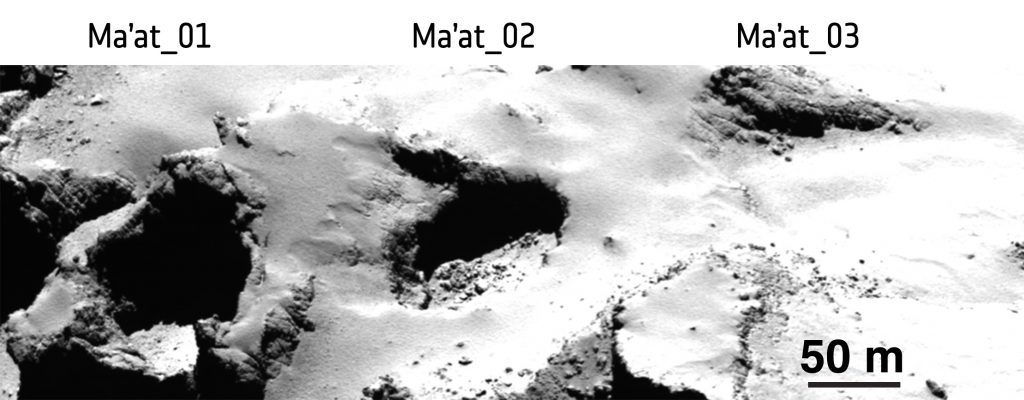
OSIRIS narrow-angle camera image taken from a distance of 28 km from the comet surface. From left to right the pits measure 125 m, 130 m and 140 m across and are 65 m, 60 m and 50 m deep, respectively. Credits: ESA/Rosetta/MPS for OSIRIS Team MPS/UPD/LAM/IAA/SSO/INTA/UPM/DASP/IDA
The target site is seen in the image below of three pits in Ma’at (first presented in a paper published in July 2015); Rosetta will target the smooth region between the pits labelled Ma’at 02 and 03.
The large, well-defined pit adjacent to the target site and identified in the image above as Ma’at 02 has now been named by the mission team as Deir el-Medina, after a pit in an ancient Egyptian town of the same name.
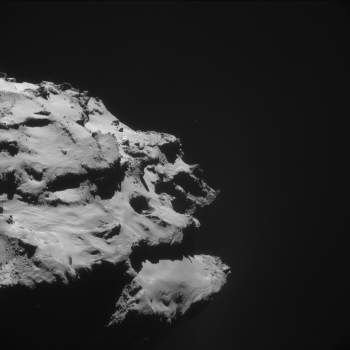
The Ma’at pits and surrounding region seen from 18 km on 8 October 2014. Credits: ESA/Rosetta/NAVCAM – CC BY-SA IGO 3.0
The pit bears resemblance in appearance to the pit in the Egyptian town that was home to many of the workers that built the pharaoh tombs in the Valley of the Kings.
The pit of Deir el-Medina, which measures about 50 m deep and 30 m wide, was originally dug by the town’s inhabitants in an attempt to find a local source water. They were unsuccessful, however, because the water table of the Nile River was much lower than it was possible to dig. Eventually the pit became the dumping ground for ‘ostraka’ the name given to discarded pieces of pottery that were used to record activities of daily life. These included, for example, short messages, love notes, medical prescriptions, receipts, recipes, and drawings.
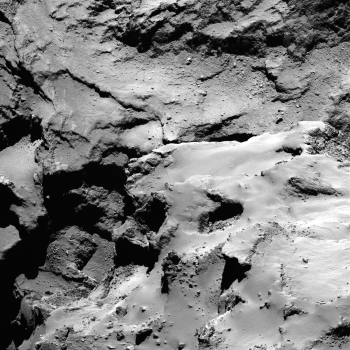
View of the Ma’at pits, including a nice view of the debris seen inside Deir el-Medina. The image was taken on 13 September 2014 from 30 km. Credit: ESA/Rosetta/MPS for OSIRIS Team MPS/UPD/LAM/IAA/SSO/INTA/UPM/DASP/IDA
Just as the historical ‘debris’ that filled the pit gives historians insight into working life in that ancient town, so the rubble that can be seen inside Ma’at 02 is helping scientists to understand the history of Comet 67P/C-G.
Indeed, in addition to the rubble seen inside the pit, the walls also exhibit intriguing metre-sized lumpy structures called ‘goosebumps’. Rosetta scientists believe these could be the signatures of early cometesimals that merged together to create the comet in the early phases of Solar System formation. Rosetta’s descent over this region therefore offers the chance to capture close-up images of these important features.
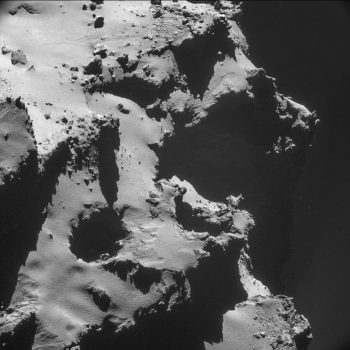
Single-frame NAVCAM image of the Ma’at pit region captured from a distance of 9.9 km from the centre of the comet on 15 October 2014. The image resolution is 84.6 cm/pixel and the size of the image is 866 x 866. Credits: ESA/Rosetta/NAVCAM – CC BY-SA IGO 3.0
In an earlier detailed study of Deir el-Medina and its neighbouring pits, scientists concluded that their differences in appearance may reflect their history of activity. While pits 1 and 2 are active, no activity has been observed from pit 3. The young, active pits are particularly steep-sided, whereas pits without any observed activity are shallower, have degraded rims, and seem to be filled with dust – and perhaps were active in the past. Middle-aged pits, like Deir el-Medina, tend to exhibit boulders on their floors from mass-wasting of the sides.
The pits – along with Rosetta’s target site – can be identified in many OSIRIS and NAVCAM images in the archive, affording many varied and spectacular views from different angles, and under a range of illumination conditions, as can be seen in some of the images accompanying this post.

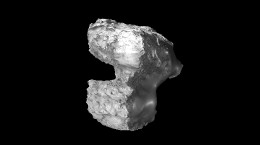
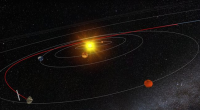
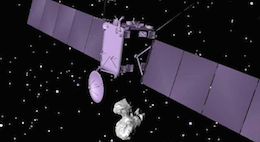
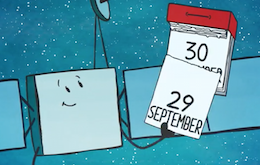
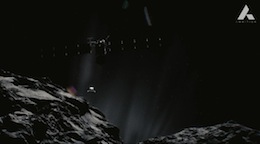
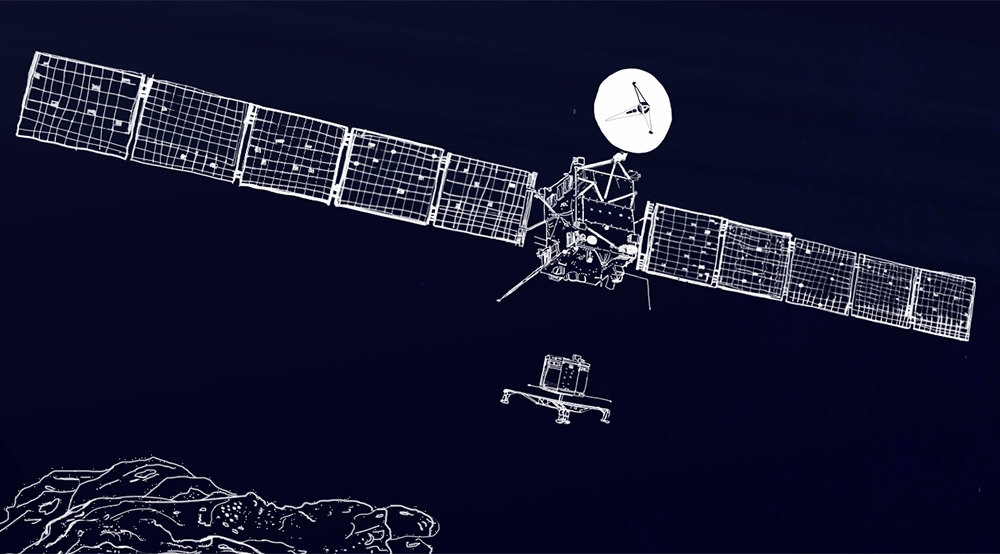
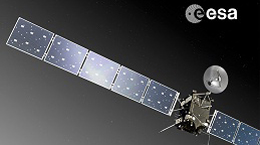
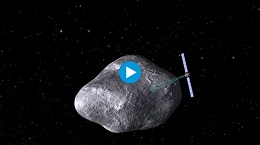
Discussion: 25 comments
“The great pit of Deir el-Medina”
Starring Harrison Ford and Sean Connery!
Hopefully they get some really interesting data from the descent. Given the resolution of some of the recent images from a few kms, then this should be really spectacular.
Gosh ian16w
Nice to see some light heartedness
Shame it’s taken the length of the project.
May the force be with you
@Dave,
Oh, believe me, there have been some posts on here that have had me in stitches! Trouble is, the posters were serious, and therefore one has to reply seriously, lest anyone take them……..seriously!
Dave
Don’t you remember this? Although I’ll grant you it might make you campaign for a ‘no puns’ mod rule 🙂 Just stumbled on it while looking for something else.
https://blogs.esa.int/rosetta/2016/07/21/final-destination-maat-region/#comment-602352
Hi Ianw16,
The interior of the pit should be, by now very very cold. The previous pictures show what look to be “dinosaur eggs”, but obviously closer images will be very funky.
Quite seriously, the pit will be a steaming potion of the funky cold Medina.
Cold coolin at a comet, and I’m lookin for some action.
But like Neil Armstrong said, I can’t get no satisfaction.
The Coma is all around, but none of the gas wants to get with me
My threads are online and I’m lookin def, yo, what’s up with Philae?
The ground crew are all jockin at the other end of the uplink.
Havin syncs with some no-name ISS, when they know that I’m the star
So I fired up and rolled over to the other side of the nu-cle-us
I asked the guys, “Why you so fly?” they said, “Deir el Medina”
Deir el Medina
This brother told me a secret on how to get more delta-v
Put a little mono-methyl-hydrazine in your tank, and the thrust’ll come real quick.
It’s better than any alcohol or hypergolic hacks
A couple of sips of this nitric potion, and you’ll be doin laps.
So I gave some to Philae when he began to decend
Then he clicked his roll and he looked up at me and did the wild thing with his leg
He used to uplink nicely, before he was much much meaner
But now he’s sittin in a rut like the Deir el Medina
You know what I’m sayin?
I got every satellite in my neighborhood breakin down my door
I got Sputnik, Venera,
V’ger from Star Trek
They won’t leave my Philae alone in that Medina, pal
I went up to this probe, she said, “Hi, my name is Selene”
I thought she’d be good to go with a little Deir el Medina
She said, “I’d like a look” I said, “Ehm – ok, I’ll go find it”
After a couple parabolic slips, then I knew that she was a lunatic.
So I took her to my crib, and studied the gravimetric girth
But when we looked, it was a big old mess, Selene was an Exogorth
So I threw him out, I don’t fool around with no space slug that’s meaner
You must be sure that the pit is pure like the Deir el Medina
You know, ain’t no plans with Han
This is the 80’s, and I’m down with the Mynocks
Ya know?
Break it down
Back in the saddle, lookin for a little nucleic acid payday
I took a shot as a contestant on that Science Friday
The audience voted, and you know they picked a winner
I took some grains from the dusty tail for COSIMA to get a glimmer
She had a few looks, but she could only find a little bit of glycin’
Instead she pointed out that hole for me to go look in.
she said, “Wait, slow down, love, not so fast says, I’ll be seein ya”
Now I’m goin’ to boldly go dive down into that Deir el Medina.
Ya know what I’m sayin
That Medina’s a monster, y’all
Deir el Medina
this is pure genius!!!!!
it fits Tone-Loc perfectly!!!
Are the People at the Bridge going to try a hovering [hummingbird like] maneuver?
“…Rosetta will essentially free-fall slowly towards the comet in order to maximise the number of scientific measurements that can be collected and returned to Earth before its impact.”
Oops! I see. The cleanliness of the final approach is of high Scientific Value itself.
Hi Logan,
Glad you brought up the “Hummingbird Hover” I have been thinking of as well.
That might be feasible but guessing only over the North or South Pole to conserve fuel and keep things relatively simple in a basically straight path hovering along with the comet, which will rotate underneath Rosetta, while she is still pointing her communication antennae at Earth.
(Emily, has the Rosetta Team considered this? Almost surely they have, so would be super interesting to know why they did not choose this as the plan, hovering and beaming as long as possible… nothing interesting on the poles, or something else?)
Logan, otherwise I think Rosetta would have to trace a very complicated and difficult corkscrew path along with Dier el Medina through space with copious amounts of fuel to “hover” there.
Another way to maximize photos and science (with much more time to transmit them) might be to orbit the equator as closely as possible, at, I guess “Baby Crawling Speed” (Is that about right Andrew?), but particle collisions and star trackers could be the problem at that level.
Guessing, that, much like NASA’s Juno has to dive through the radiation belts of Jupiter quickly to minimize exposure, to get in and out safely, Rosetta needs to minimize chance for star trackers to get confounded for its one way trip “in only”.
Guys, I really just worry about Rosetta having adequate time to beam back fantastic IMAGES, as a space science enthusiast, even more so than the science itself at this point. As probably do tens of millions of fascinated Earth Science Enthusiast like myself!
Emily, can the Team speak to the chances of getting a few dozen amazing images with your Final Plan?
Thanks so much for the Ride of a Lifetime….Rosetta Team, Philae Team and ESA!
Actually I should have said, “Hundreds of millions of Space Science Enthusiasts desiring great final close-up photos!”
Hi Ramcomet, all,
We’re waiting for timelines on what science operations are happening when, but for sure there will be images taken during the final descent. Hope to provide more details on this aspect later…!
Hi Ramcomet
The ducky-synchronous orbit radius is theoretically 3.281 km from the centre of gravity. That’s about 700-800 metres above Apis (an informed guess) if that were the target. But that’s only if the c of g is a point source at the centre of a sphere so it’s rather academic and there would be serious drifting off station for a duck shape. Orbital speed would be about 0.45m/sec, toddler speed.
However, seeing as the drift distance is proportional to the time squared that the g acceleration anomaly is acting on Rosetta, the drift is slow at first, assuming perfect ducky-synchronous orbit insertion. I reckon you could stay put or nearly so for 15 minutes or so. It then depends on whether that’s worth the delta v (fuel) cost to insert then inject to a new, 10-15km or so apoapsis ellipse.
Ducky-synchronous only works with an equatorial plane orbit, as you say, but you could still scan areas either side. It’s still a bit high though, compared with the really close scenarios.
I would have thought it possible to exploit the station drift if inserting in certain areas like above Anuket and being slowly pulled back towards Apis, taking data all the way. I don’t think there’d be too much of an out-of-plane anomaly there.
I’m sure they’ve thought of ducky-synchronous so I must be missing something. Dust?
Hi Andrew,
Actually, I wasn’t thinking ducky-synchronous orbit, but it is very interesting to know GSO (or DSO?), is about 3.281 km from the CG, grazing Apis about 700-800 meters above with some drift.
Would not be a bad height gear up at, then slowly drift down from, as 67P rotates beneath, for such an exciting Comet-obstacle “Wipeout Run”, like the TV game show’s gauntlet run, until the inevitable outcrop finally snags Rosetta!
Sure, a Non-DSO doesn’t guarantee study in a specific area, but gets snapshots all the way around while corkscrewing slowly down to the end with much more transmitting time, than a linear crash.
I agree though… also think dust must be the problem with either a DSO or just my idea of a low, low, and slow, slow “feather brushing” orbit. Because, the last time she approached that low, Rosetta’s star trackers got confused by dust particles and it took quite some nail-biting time to get her back out of safe mode.
She would likely never come out of safe mode in this case and crash with no images or science beamed back at all.
Still I wonder where the densest particle halo is located now above the comet and whether it extends all the way down the the surface, or whether there is a mostly “safe clear zone” within, say, 10 km.
Ah, but even so, star trackers would likely still be confused by particles above, if not cliffs of Hathor and lobes” head and tail “feathers” swinging by!
Anyway, even with the Kamikaze Run, as Logan said, the last drop of wine will be mighty tasty!
“…even with the Kamikaze Run…” On a certain lighting, We also are having a few Stuka Junker Runs 😀
Hi Ramcomet. This wine is going to be the best till the last drop 🙂
Image ESA/Rosetta/NAVCAM – CC BY-SA IGO 3.0
above.. still looks more like nice doggie than any obscure EgyptIan pit. . could be an Egyptian Woof Woof.. no ?
Outstanding accomplishment Kudos to you all. Hopefully the world will take notice what can be accomplished if we all work together
amazing photo.. really gives you an insight to the pit
Hello! The photo https://blogs.esa.int/rosetta/files/2016/09/N20140913T024504369ID30F22-350×350.png noticeable “striped” structure, which is probably a consequence of the stratification of the field of the comet? The structure is not apparent for a simple look. I saw her looking at the photo without the usual points for me. Photography seemed slightly blurred, and this made it possible to escape from the surface of the fine detail and focus on the more general terms of the surface. The layered structure I highlighted with colored dots on this photo here: https://goo.gl/photos/JL4Qa3FYW8kRqt9r8
It seems to me, or this structure really exists? Thank you for your excellent work!
Hi Vadim. Beautiful structure down there. There are more at some other shots, at the Open ESAC Library, so smooth that could pass by giant salt grains [As seen from the distance].
Here is the link to the full size beautiful OSIRIS shot of Deir el-Medina:
https://imagearchives.esac.esa.int/action.php?id=46839&part=e&download
A dusted-off square at px{964,1407}, probably by matrix-jetting or electrostatics?
Hey Logan,
Banking on the “there are no stupid questions, optimistic rule for dummies”, can you describe clearly how an amatuer can use your pixel intersection information to locate what you are seeing?
I can then go back and learn from your dozen or more previous posts in this blog where you point out positions, armed with this technique.
I don’t have any fancy software. Thanks!
Ram: All OSIRIS 2048^2.
So, starting for upper left corner, that is:
47% right and 69% down, from whatever your screen size or resolution shows. Try:
https://imagearchives.esac.esa.int/action.php?id=46839&part=e&download
Useful to build a card rule if your zooming is steeped at 1,5x,2x,3x.
NAVCAM are all 1024^2